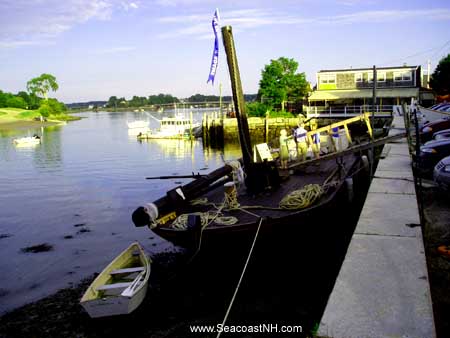|
FRESH STUFF DAILY |
|
|
||
|
|
||
|
|
||
|
SEE ALL SIGNED BOOKS by J. Dennis Robinson click here |
||
Page 3 of 3 Portsmouth, NH South End (continued)
Mary Mills Laighton also gave her husband 13 children, four girls and nine boys. The Laighton boom coincided with the best economic years in Portsmouth history. During this era many large family tracts were subdivided and we know that at least three of the Laighton boys built houses in their parent’s back yard. The Benedicts house and an identical Federal next door appeared soon after the start of the Revolution. The 1778 date is an educated guess since no deed has yet been discovered. By 1797, when Paul Laighton’s elderly father-in-law finally deeded him the entire parcel, the houses were there. Paul Laighton immediately passed the land on to his sons. Local historians speculate that Paul may have retired to the smaller Benedict house where the Benedicts will soon retire themselves. His second-youngest son Samuel Laighton, born in 1786, may have lived there next. The paper trail has faded, but we know that Samuel, like all of the Laighton boys, was also a block maker. Samuel would have been only three when President George Washington passed through the South End in 1789. Washington was on his way to Hunking Street to visit the mother of his secretary Tobias Lear. Lear, perhaps the most famous South-ender, also acted as bookkeeper at Mount Vernon and tutor to Washington’s stepchildren. Tobias Lear’s birthplace, a 1740 hip-roofed house, still sits at the end of Hunking Street right next to the Wentworth-Gardner mansion. Both are now South End museums. When you buy a house in the South End, the Benedicts have discovered, you buy into a neighborhood – and its history. Some of those neighbors are alive and some, like the Laightons, the Wentworths and the Lears, are very palpable ghosts who still command attention. One more famous neighbor deserves mention. In 1793, about the same time that Paul Laighton officially got the deed to his side of the street, the Wentworth property next door was sold. The new owner was Major William Gardner, who was also connected to George Washington. During the Revolution, Gardner’s job was to furnish soldiers with supplies, a difficult task since the nascent government had no funds to speak of. Gardner was forced to use his own money, at times, and was never repaid. In thanks Washington made him regional Commissioner of Loans. Gardner set up the United States Loan Office inside an arch that stretched over the street at the top of his property. That would place his unusual office just across Gardner Street from the Benedict house. The Gardner Arch survived until 1850. The appeal of Gardner Street, Susan Benedict says, is that they can live simultaneously in the 18th and the 21st centuries. The trick is to find the perfect balance – the best of both worlds, the worst of neither. "There’s something special about the South End," says Bob Lacivita, a carpenter who has worked on ten South End homes, including the Benedict house. "In New Hampshire people don’t necessarily just walk up and say – Hi, how are you? – but they do here. Maybe because it was a real working-class neighborhood. It was friendly like that when it was all run-down years ago. It’s still like that today." (c) 2007 by J. Dennis Robinson. All rights reserved. A longer version of this article appeared previously in an edition of Early America Life with detailed photographs.
Please visit these SeacoastNH.com ad partners.
News about Portsmouth from Fosters.com |
| Tuesday, April 23, 2024 |


|
Copyright ® 1996-2020 SeacoastNH.com. All rights reserved. Privacy Statement
Site maintained by ad-cetera graphics

 HISTORY
HISTORY



















